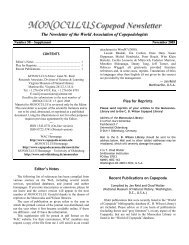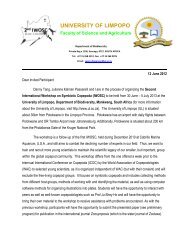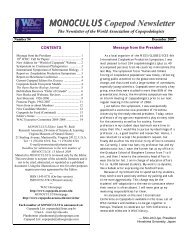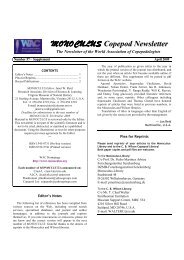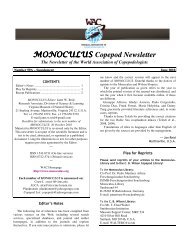MONOCULUS Copepod Newsletter - World Association of ...
MONOCULUS Copepod Newsletter - World Association of ...
MONOCULUS Copepod Newsletter - World Association of ...
Create successful ePaper yourself
Turn your PDF publications into a flip-book with our unique Google optimized e-Paper software.
workshop and symposium. What do you need to become aparticipant or supporting member <strong>of</strong> a copepod genomicsproject? In addition to educating our membership aboutgenomics approaches, we could have a dialogue on a widerange <strong>of</strong> topics, including additional choices <strong>of</strong> candidatespecies for sequencing. One example <strong>of</strong> how we mightapproach a community wide discussion is described on awebsite (http://www.biology.uiowa.edu/workshop/)maintained by investigators <strong>of</strong> protists, who gatheredtogether to choose candidate species for their first genomesequencing efforts.We think that now is the time for copepodologists to takeadvantage <strong>of</strong> new technologies in genomics. As acommunity, we can benefit from the successes and mistakes<strong>of</strong> prior sequencing efforts on other taxa. The hardest worklies ahead: mobilizing the copepod community, preparingthe grant proposals, … and finally annotating the finalsequences. We welcome input from investigators who areengaged in research that would benefit from a copepodgenome sequencing project in the immediate future (e.g.,QTL-mapping, resolving deep phylogenies, quantitativegenetics, molecular genetics, molecular physiology,adaptation, gene expression analyses, etc.). To participate inthe discussion, subscribe to a listserve created specificallyfor discussion by sending an email to COPEPODGENOME-L@listserv.jmu.edu. Grace Wyngaard will add your name tothe subscriber list. We will begin this discussion group as anunmoderated one, so that messages are shared with allparticipants instantaneously. If problems arise, such assubscribers sending spam, James Bron and Grace Wyngaardwill moderate. Let the discussion begin!References― Grace WyngaardJames Madison University, U.S.A.(wyngaaga@jmu.edu)andCarol Eunmi LeeUniversity <strong>of</strong> Wisconsin, Madison, U.S.A.(carollee@wisc.edu)1. Lee, C.E. 1999. Rapid and repeated invasions <strong>of</strong> freshwater by the saltwater copepod Eurytemora affinis.Evolution 53:1423-1434.2. Engel, R.A. 1962. Eurytemora affinis, a calanoid copepodnew to Lake Erie. Ohio Journal <strong>of</strong> Science 62:252.3. Faber, D.J., E.G. Jermolajev & E.G. Kossiakina. 1966. Anew copepod genus in the plankton <strong>of</strong> the Great Lakes.Limnology and Oceanography 11:301-303.4. Huq, A. et al. 1983. Ecological relationships betweenVibrio cholerae and planktonic crustacean copepods.Applied Environmental Microbiology 45:275-283.5. Colwell, R.R. 2004. Perspectives: Infectious disease and10environment: Cholera as a paradigm for waterborne disease.International Microbiology 7:285-289.6. Piasecki, W., A.E. Goodwin, J.C. Eiras & B.F. Nowak.2004. Importance <strong>of</strong> copepoda in freshwater aquaculture.Zoological Studies 43:193-205.7. Meibom, K.L., M. Blokesch, N.A. Dolganov, C.-Y. Wu &G.K. Schoolnik. 2005. Chitin induces natural competence inVibrio cholerae. Science 310:1824-1827.8. Reguera, G. & R. Kolter. 2005. Virulence and theenvironment: a novel role for Vibrio cholerae toxincoregulatedpili in bi<strong>of</strong>ilm formation on chitin. Journal <strong>of</strong>Bacteriology 187:3551-3555.9. Lee, C.E., J.L. Remfert & G.W. Gelembiuk. 2003.Evolution <strong>of</strong> physiological tolerance and performance duringfreshwater invasions. Integrative and Comparative Biology43:439-449.10. Eads, B.D., G.W. Gelembiuk, M. Posavi & C.E. Lee. (InPrep.) Evolutionary shifts in gene expression pr<strong>of</strong>iles acrossindependent invasions by the copepod Eurytemora affinis.Molecular Biology and Evolution.11. Skelly, D., G. Winkler & C.E. Lee. (In Prep.) Reactionnorm differences between sympatric invasive andnoninvasive populations <strong>of</strong> the copepod Eurytemora affinis.12. Grishanin, A.K., E.M. Rasch, S.I. Dodson & G.A.Wyngaard. 2005. Genetic architecture <strong>of</strong> the cryptic speciescomplex <strong>of</strong> Acanthocyclops vernalis (Crustacea: <strong>Copepod</strong>a).II. Crossbreeding experiments, cytogenetics, and a model <strong>of</strong>chromosomal evolution. Evolution 60:247-256.13. Dodson, S.I., A.K. Grishanin, K. Gross & G.A.Wyngaard. 2003. Morphological analysis <strong>of</strong> some crypticspecies in the Acanthocyclops vernalis species complex fromNorth America. Hydrobiologia 500:131-143.14. Lee, C.E. 2000. Global phylogeography <strong>of</strong> a crypticcopepod species complex and reproductive isolationbetween genetically proximate "populations". Evolution54:2014-2027.15. Lee, C.E. & B.W. Frost. 2002. Morphological stasis inthe Eurytemora affinis species complex (<strong>Copepod</strong>a:Temoridae). Hydrobiologia 480:111-128.16. Edmands, S. & J.S. Harrison. 2003. Molecular andquantitative trait variation within and among populations <strong>of</strong>the intertidal copepod Tigriopus californicus. Evolution57:2277-2285.17. Rasch, E.M., C.E. Lee & G.A. Wyngaard. 2004. DNA-Feulgen cytophotometric determination <strong>of</strong> genome size forthe freshwater-invading copepod Eurytemora affinis.Genome 47:559-564.



